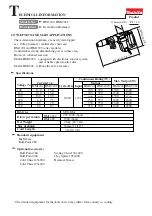Reviews:
No comments
Related manuals for Mini Mill

HM1202
Brand: Makita Pages: 14

980
Brand: 3M Pages: 11

DTS 5800
Brand: WAGNER Pages: 12

2025 SERIES
Brand: Alcoa Pages: 22

ASye 636 Kinetik
Brand: Fein Pages: 77

5080e
Brand: Rapid Pages: 9

WC503AC
Brand: VONROC Pages: 84

HD-46C
Brand: Eriez Pages: 12

6040-XTS
Brand: X-Tronic Pages: 8

Earlex WS125
Brand: WAGNER Pages: 56

028673
Brand: BorMann Pages: 9

Z31169
Brand: Powerfix Profi Pages: 10

02823
Brand: Gude Pages: 44

DSRK-B6
Brand: Allway Pages: 4

MultiPower-6-NT
Brand: G&D Pages: 60

AP-AY1506
Brand: AP&T Pages: 3

BT2HT
Brand: Panduit Pages: 4

28D-1
Brand: Secura Pages: 8

















